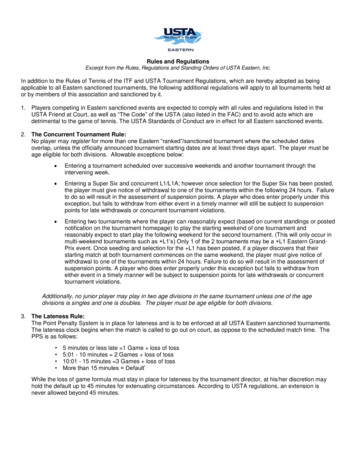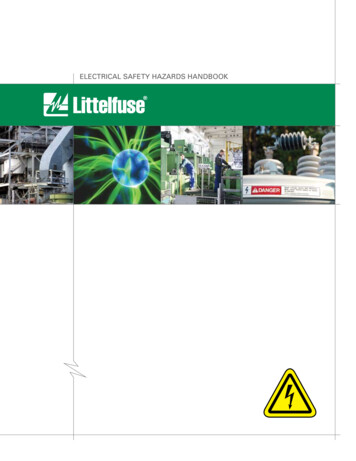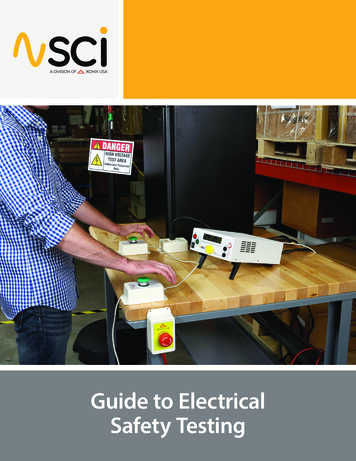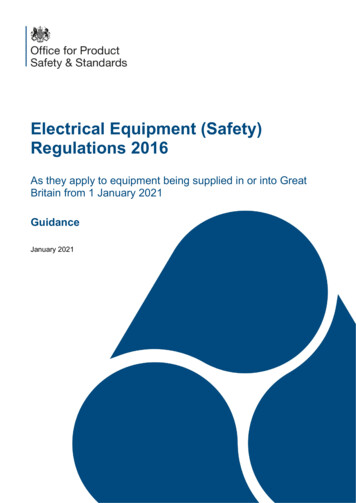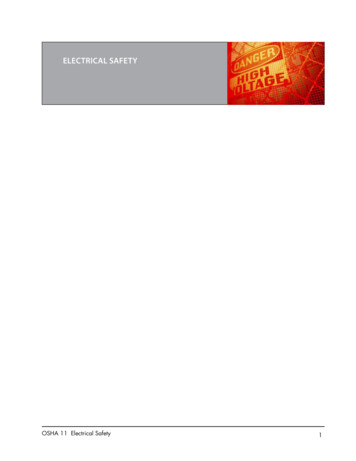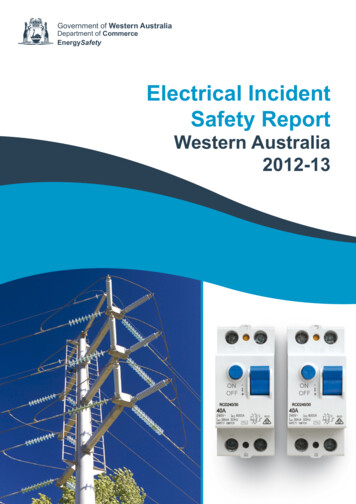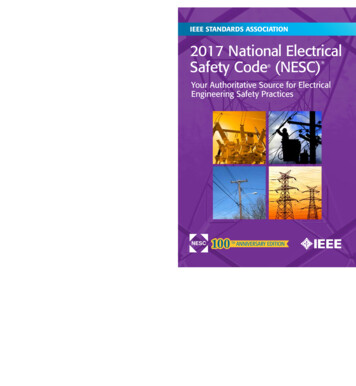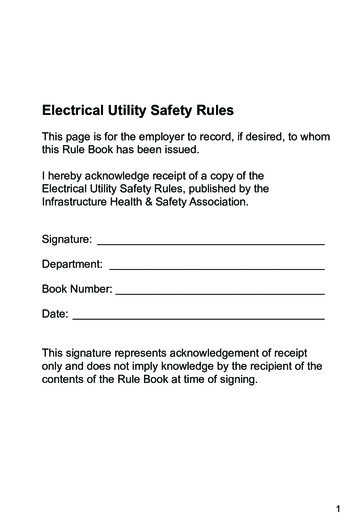
Transcription
Electrical Utility Safety RulesThis page is for the employer to record, if desired, to whomthis Rule Book has been issued.I hereby acknowledge receipt of a copy of theElectrical Utility Safety Rules, published by theInfrastructure Health & Safety Association.Signature:Department:Book Number:Date:This signature represents acknowledgement of receiptonly and does not imply knowledge by the recipient of thecontents of the Rule Book at time of signing.1
This page left blank intentionally2
Infrastructure Health & Safety AssociationFOREWORDThese safety rules (revised January 2019) are for thepurpose of preventing personal injury, illness and propertydamage. However, be aware that the rules expressed areminimum requirements for the workplace and for publicsafety.These rules were revised with input from key stakeholdersand the dedicated efforts of a Joint Working Teammade up of representatives from Hydro One Inc. and theInfrastructure Health & Safety Association (IHSA).The Electrical Utility Safety Rules are a reflection of theexperience of the membership and others of the industry,and the knowledge to identify, eliminate and controlhazards and prevent injuries and illnesses.In addition to these rules, the current Ontario OccupationalHealth and Safety Act (OHSA) and Regulations outlinespecific duties and responsibilities of employers andworkers. These safety rules must be used in conjunctionwith existing federal and provincial health and safetyregulations.3
ApplicationThe following safety rules have been designed primarilyfor work in the electrical utility industry. However, the rulesapply equally well to any work performed on or in proximityto electrical transmission or distribution systemsor apparatus. These rules are in addition to all otherpertinent safety rules, and are to be used to comply withcurrent Regulations made under the Ontario OccupationalHealth and Safety Act and all other applicable legislation inOntario.Enzo Garritano,President and CEOIHSA4Paul Dobson,Acting President and CEOHydro One Inc.
l.16101Employer’s Management of Rules.16102Knowledge of Rules.16103Personal Conduct.17104Physical and Other Limitations.17105Jewelry and Long Hair.17106Authorization for Work.17107Job Planning.18108Weather Conditions.19109Operating Maps and Component Nomenclature.19110First Aid.20111Emergency Response.20112Rescue Operations.21113Arc Rated/Flame Resistant Protective Equipment.21114Safe Conditions for Work.22115Work on Isolated Circuits.23116Work on Neutral Conductors,Buses and Skywires.23117Establishment of Hold-Offs.23118Static Electricity and Induction.24119Use of Temporary Grounds.24120Electrical-Testing Devices.25121High-Voltage Testing.25122Working Alone.26123Aerial Devices/Boom Trucks.27124Raising and Lowering of Tools and Material.30125Switching Authorization.31126Switching Operations.32IHSA Supplemental.32Hydro One Inc. Supplemental.335
31441451461471481496Guarding and Safety Interlocking forPersonnel Protection. 33Apparatus to Be Treated as Energized. 34Safe Limits of Approach. 35Items in Direct Contact withEnergized Apparatus. 42Painting. 42Work on or in Proximity to Energized Apparatus.42Authorization for Live Line Work. 43Inspection, Testing and Selection of Live LineTools, Protective Equipment and Aerial Devices. 43Rubber Glove Work. 46IHSA Supplemental. 48Hydro One Inc. Supplemental. 49Live Line Tool Work. 50Barehand Work. 50Stringing and Removing Conductors. 51Hoists. 52Confined Spaces. 52Working on Cables and AssociatedEquipment. 53Pulling Cable. 54Portable Ladders. 55Scaffolds. 55Overhead Conductor Insulation. 56Temporary Power Cables. 56Cord-Connected Electrical Equipment. 56Mobile Transformers. 57Backfeed. 57
DEFINITIONSAliveSee “Energized.”ApparatusAll equipment pertaining to the generation, transmission,distribution and use of electricity.ApprovedA device or method that has been evaluated and selectedfrom alternatives that meet the specific requirements ofthe job.Approved PracticeA trade skill or work procedure used in situations whereisolation of energy sources is not used. It can only be usedto provide safety for the person who is exercising theapproved practice.Skills are developed from a combination of education,training and experience. Approved practices are normallydocumented in training material, trade handbooks or workmethods instructions.Approved Work Procedure(s)An approved, documented, step-by-step method thatensures the task can be performed safely.Arc FlashA dangerous condition associated with the release ofenergy caused by an electric arc.Arc Rated (AR)/Flame Resistant (FR) NEWThe value attributed to materials that describes theirperformance to electric arc flash events.7
The property of a material whereby combustion isprevented, terminated, or inhibited following theapplication of a flaming or non-flaming source of ignition,with or without subsequent removal of the ignition source.Authorized Worker(s)A worker who has been given formal permission by theowner and employer and is competent to perform work inproximity to energized apparatus.BondedElectrically connected to ensure that two or more objectsare at the same potential.Bonding (electrical)Making a mechanically secure electrical connectionbetween two or more objects to ensure they are at thesame potential.Cable(s)All insulated conductors used for transmitting ordistributing electrical energy.Certified Insulated Aerial Device(s)An aerial device that has successfully passed dielectrictesting of the insulated portion of the boom, as prescribedby a certified laboratory.Certified Laboratory Rev 01/19A laboratory that has received certification from a governingagency, and has established specific testing standards forelectrical equipment, tools, protective equipment and aerialdevices.8
ChargedIsolated but not de-energized; containing stored energy.Electrical equipment not physically connected to a source ofenergy may still be charged through induction orcapacitance.Competent PersonA person who,a) is qualified because of knowledge, training andexperience to organize work and its performance;b) is familiar with the provisions of the OccupationalHealth and Safety Act and the Regulations that applyto the work; andc) has knowledge of any potential or actual danger tohealth or safety in the workplace.Competent WorkerIn relation to specific work, means a worker who,a) is qualified because of knowledge, training andexperience to perform the work;b) is familiar with the Occupational Health and SafetyAct and with the provisions of the Regulations thatapply to the work; andc) has knowledge of all potential or actual danger tohealth or safety in the work.Conductor(s)That part of a cable, overhead line or apparatus intendedto conduct the flow of electrical energy.Confined Space(s)A fully or partially enclosed space,a) that is not both designed and constructed forcontinuous human occupancy; andb) in which atmospheric hazards may occur because of itsconstruction, location or contents or because of workthat is done in it.9
Controlling AuthorityThe person(s) who occupies a position responsible for thecontrol of specific equipment and devices. This includesthe responsibility for performing, directing or authorizingchanges in the conditions or in the position of theequipment or devices.Critical HazardA condition that has the potential for unwanted energyflow that may result in an injury to a worker or the public.Dedicated ObserverA worker competent in the tasks being performedand having no other duties while monitoring the workcontinuously.Dedicated Signal Person NEWA competent worker, designated as a signaller, havingno other duties while monitoring the work continuously.They shall be positioned in full view of the operator with aclear view of the energized electrical apparatus and of thevehicle or equipment.De-EnergizedWhere electrical energy has been discharged through amechanically secure connection to an effective groundpotential.Drop Zone NEWThe area identified as the location where there is potentialfor electrical hazard or objects to fall to the ground whilework is being performed aloft creating a risk to workers orthe public.10
Dynamically AliveConnected (that is, not isolated) to a source of energysuch as an electrical generator, storage battery, or othersource of electrical energy.EmergencyA situation, that requires immediate action to preventserious adverse effects on the health and safety ofemployees, the public or the environment. An emergencymay be the result of uncontrolled explosions, fires,releases of hazardous materials or natural disasters.Emergency Response PlanA documented and communicated process designed toensure a safe environment for all workers and the publicto be used when responding to a specific emergency.Employer(s)A person who employs or contracts the services of one ormore workers.EnergizedCapable of delivering energy by reason of beingdynamically alive or charged.EquipotentialWhere no differences in electrical potential exist.Equipotential ZoneA work area where no differences in electrical potential exist.FRPFibre Reinforced Plastic.11
Grounded Rev 01/19Mechanically secure connection to an effective groundpotential.Hazard(s)A source of energy that may affect the safe work area.Hold-Off(s)A device having its operation restricted to previouslyagreed limits by the placement of a hold-off tag. Holdoffs are most commonly used to block the automatic reclosingor the manual re-energization of a line following an automatictrip.Hold-offs are for equipment protection and must not beused in place of a work permit.HolderThe person who has accepted the Work permit or SupportingGuarantee and therefore has attained working and/ortesting rights for the work group. The Holder is assignedresponsibilities for ensuring that everyone in the work groupis protected from the viewpoint of the Utility Work ProtectionCode.InductionVoltage produced on a conductive object that is subjectedto a changing magnetic field.IsolatedSeparated from all sources of dynamic energy.Isolated ZoneA section of line or portion of apparatus between isolationpoints, separated from all sources of dynamic energy.12
Job PlanA work plan agreed to by all workers involved thatidentifies all known hazards, eliminates the hazards wherepractical, controls the hazards that cannot be eliminated,protects against injury if a hazard gets out of control,minimizes the severity of an injury if one takes place andidentifies each worker’s responsibilities in the performanceof the work.LinesAll overhead conductors used for transmitting ordistributing electrical energy.Line Clearing Operations NEWRemoval of vegetation in proximity to energized electricalapparatus.Live Line WorkWork activities carried out by authorized workers onlive conductors and associated apparatus, using specialequipment and approved work procedures.Maintenance Chamber and/or VaultA chamber or enclosure used in an underground electricaldistribution system to house electrical apparatus or theentrance way thereto.Nominal VoltageThe normal operating voltage measured phase-to-phaseon multi-phase equipment, or phase to neutral on singlephase equipment.Non-Insulated Booms and Non-Insulated Portion ofAerial DevicesAn articulated or extendable lifting device with no testedelectrical insulating qualities.13
Personal Protective EquipmentApproved safety equipment worn and used to reduce therisk of personal injury.ProximityProximity is defined by the following limits of approachand does not apply to apparatus that is designed, builtand installed to be intrinsically safe for human touch,a) within 3 metres (10 feet) of energized apparat
Book Number: _ Date: _ This signature represents acknowledgement of receipt . However, the rules apply equally well to any work performed on or in proximity to electrical transmission or distribution systems or apparatus. These rules are in addition to all other pertinent safety rules, and are to be used to comply with current Regulations made under the Ontario Occupational Health .
